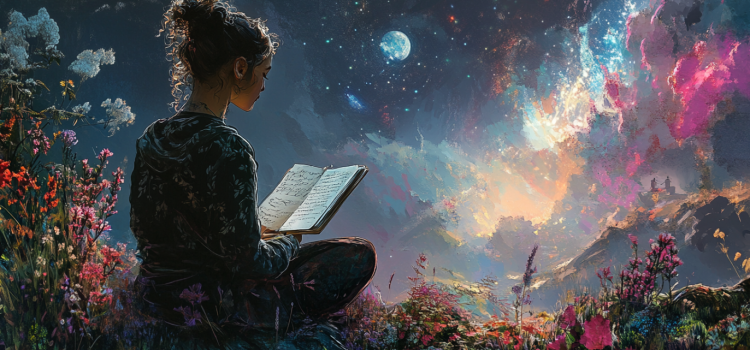
What does it actually mean to be creative? Is creativity something you’re born with or something you need to practice?
In his book Creative Quest, four-time Grammy winner and The Roots co-founder Questlove discusses four ways to be more creative. His list includes keeping an open mind, being mindful, planning your work, and changing your mindset about creativity.
Here’s a look at each creative method in detail.
What Is Creativity?
Before we jump into ways to be more creative, it’s important to understand what creativity is. Questlove defines creativity as the process of making something new. He argues that being creative isn’t just something traditional artists do—everyone can be creative. A parent who designs fun activities for their kids can be just as creative as a professional filmmaker.
According to Questlove, creativity allows us to leave our imprint on the world. When we create something, we prove we can change our surroundings and make a difference in our communities and in other people’s lives. For example, if you’re an indie game developer, you can see how your games inspire people, give them comfort, or help them connect with friends.
| Other Definitions of Creativity While Questlove views creativity as a process, other authors view creativity as more of a spiritual force or natural state of being. In The Creative Act, music producer Rick Rubin agrees with Questlove that creativity is available to everyone. However, he argues that creativity isn’t something you do, but rather a way of being in the world. Rubin suggests that you’re naturally creative just by existing and expressing yourself through the clothes you wear, the relationships you build, or even how you move to music. He believes creativity flows through you from a universal source of inspiration, and your unique life experiences act as a filter that shapes these creative impulses into something original. Similarly, in Big Magic, author Elizabeth Gilbert offers a spiritual view of creativity, describing it as a commitment to exploring your unique gifts. She argues that a spiritual, cosmic force of creativity exists independently of humans and constantly tries to communicate with us through ideas. She believes these ideas float around in the universe, seeking people who will bring them to life, rather than originating from within our own minds. |
Ways to Be More Creative
According to Questlove, you don’t need special training to be creative—you just need to practice using the skill and learn to trust your creative instincts. In this section, we’ll discuss ways to be more creative using tips like keeping your mind open to new ideas, setting up your workspace, planning creative projects, and maintaining your creativity as you age.
1. Keep an Open Mind
First, Questlove writes that the key to creativity is to let your mind remain open and receptive to ideas. You can do this by:
1. Accepting all ideas that come to mind. When doing creative work, it can be tempting to immediately judge ideas that pop into your mind as good or bad. But if you’re too quick to dismiss ideas, you might prematurely filter out valuable ones. You’ll also feel frustrated as you try to generate perfect ideas. Questlove argues that by entertaining your ideas longer, no matter how strange or far-fetched they may seem, you might discover connections you’d otherwise miss and also stay in a creative flow. To stay open to initial ideas, remind yourself that editing and refinement can come later.
2. Relaxing your mind. Research shows it’s easier to be creative when you’re slightly tired and unfocused than when you’re fully alert. This is because fatigue lowers your mental filters, allowing you to have more random thoughts and connections. To relax your mind, Questlove recommends taking small mindfulness breaks while you work: Step back from whatever you’re doing for 15 to 60 seconds. For example, if you’re stuck on a paragraph of your novel, take a short pause to reset your thinking. These breaks are short enough that you won’t disconnect entirely from your work, but they give your mind the space it needs to generate new insights.
(Shortform note: The reason mindfulness breaks work is because your brain naturally switches between a focused and diffuse mode of thinking. In A Mind for Numbers, Barbara Oakley explains that focused mode is like zooming in on details like a camera lens while diffuse mode is like a zoomed-out view. When you’re stuck on a problem, staying intensely focused can work against you due to something called the “Einstellung effect,” where you get fixated on one approach. When you take those short breaks that Questlove recommends, you give your brain permission to shift into diffuse mode, where it can work on problems in the background and potentially generate “aha” moments.)
| Adopt a Childlike Imagination In The Creative Act, Rubin explains that the reason we filter out ideas is because we categorize, compare, and edit information to make ideas easier to process. He notes that we only start doing this as we grow older—as children, we’re incredibly creative because we focus more on possibilities. In Wired to Create, Scott Barry Kaufman and Carolyn Gregoire expand on this, pointing out that the most creative adults are those who still have this childlike imagination. They explain that people who engaged in imaginative play as children tend to be more creative as adults than those who didn’t engage in imaginative play. Rubin gives advice for opening your mind to all the possibilities again: 1. Break free from rules that might be holding you back. These include rules you’ve made for yourself, standard practices in your field, or expectations from others. While these traditional approaches can be a starting point, being too rigid about following them can stifle your creativity. 2. Adopt a beginner’s mindset. Approach your work with curiosity and humility as if you’re seeing it for the first time. This mindset helps you break out of your usual thought patterns and encourages you to experiment without fear of failure. |
2. Be Mindful of What Helps and What Hinders You
Second, to support your creativity, Questlove recommends being mindful of the things that comfort you and help put you in a creative mindset. He recommends getting rid of distractions without denying yourself the small pleasures that ground or soothe you. He explains that some people try to avoid distractions by avoiding small pleasures—whether it’s background music, snacks, or a sensory indulgence. However, he argues that denying yourself these small comforts is more distracting, since you’ll spend time longing for them instead of focusing on your work.
For example, if you’re hungry when working but force yourself to wait until dinner to eat, you might spend more time watching the clock and thinking about what you’ll eat later instead of focusing on your creative work. Having a small snack while you work prevents hunger from distracting you, helping you stay more focused and engaged in the creative process.
| Why Do We Get Distracted? In Indistractible, Nir Eyal’s theory about where distractions come from supports Questlove’s advice to let yourself have small pleasures. He explains that distractions start inside you, not from outside sources. When we feel uncomfortable emotions like hunger, frustration, or boredom, we look for ways to escape those feelings. For example, if you’re struggling to write the first page of a novel, you might check social media—not because social media itself is distracting, but because it helps you avoid the discomfort of getting started. This is why small pleasures actually help you focus better. When you make yourself comfortable—like having a cup of your favorite tea or playing soft background music while working—you’re less likely to seek escape through distractions. These small comforts reduce your inner discomfort, making it easier to stay focused on your task. |
3. Plan Your Work
According to Questlove, you must also plan your creative projects. He argues that the most successful works incorporate elements of both planning and spontaneity. Having a plan gives you the necessary direction and purpose; however, following it too rigidly can make work feel stale and unoriginal. So, you must also leave room for unexpected choices that make your work fresh and exciting to engage audiences.
Questlove suggests two tips for planning your work:
1. Start with a basic plan. Carve out a general direction for your work, but stay open to ideas that might emerge during the creative process. For a writer, this might mean developing your plot points and character arcs but letting dialogue or scenes arise spontaneously as you write the story.
2. Imagine the final result of your work. Visualize how your work will be presented and how your audience will receive your work. Rather than trying to please everyone, focus on connecting with your specific audience. Even if your work speaks to a smaller group, it can have a powerful impact on those who truly connect with it.
Consider the Natural Planning Method for Your Creative Work
In Getting Things Done, David Allen provides a step-by-step guide that can help you create the basic plan that Questlove suggests. His Natural Planning Method breaks down how our minds naturally approach projects, making complex work more manageable.
1. Define your purpose. Start by asking yourself why you’re doing the project and what boundaries you need to set. This clarity helps you make better decisions, stay motivated, and measure success. For example, instead of saying “I want to write a story,” specify “I want to write a compelling mystery novel that keeps readers guessing until the final page.”
2. Visualize the outcome. Questlove recommends visualizing the final result, but Allen also suggests you picture exactly what success looks, sounds, and feels like. Athletes use this visualization technique to improve their performance—seeing themselves crossing the finish line helps them achieve it. The more specific your vision, the more likely you are to create it.
3. Brainstorm freely. Generate as many ideas as possible without critiquing them. Don’t try to organize while brainstorming—that comes later. Allen recommends you write everything down to free up your mind for more creative thinking. You can use mind maps or webs to capture ideas in a less structured way.
4. Organize your ideas. Look for natural patterns in your brainstormed ideas and sort them into components (main parts), priorities (what’s most important), and sequences (what needs to happen first). This step turns your creative chaos into a workable plan.
5. Identify next actions. Break down each component into specific, actionable steps. If you’re working with others, make sure everyone knows their next tasks. This detailed planning often reveals issues you hadn’t considered and helps you start making real progress.
4. View Creativity as a Journey
Lastly, Questlove writes that making creative work takes time and patience, so he suggests you view creativity as a lifelong journey. He argues that creators must work regularly on their craft, even when they don’t feel inspired. Some days you’ll feel excited to create, while on other days it might feel like a chore. Both types of days are normal and necessary. The key is to keep showing up and doing the work, knowing that mastery develops over time.
Questlove urges you to continue doing creative activities as you grow older because creative activities keep your brain sharp. Some people stop being creative because they think they’re too old or find it harder to do things they used to do, but giving up creative activities makes doing things harder.
To maintain your creativity as you age, Questlove suggests two strategies. First, spend time with younger people and learn about new trends—attend their concerts, look at their art, or join their book clubs. This exposure to fresh perspectives keeps your mind open to new ideas. Second, adapt your creative routine to match your current abilities. If age-related changes make your usual creative routine difficult—for example, if your hands aren’t as steady for painting—adapt by using larger brushes or trying digital art.






